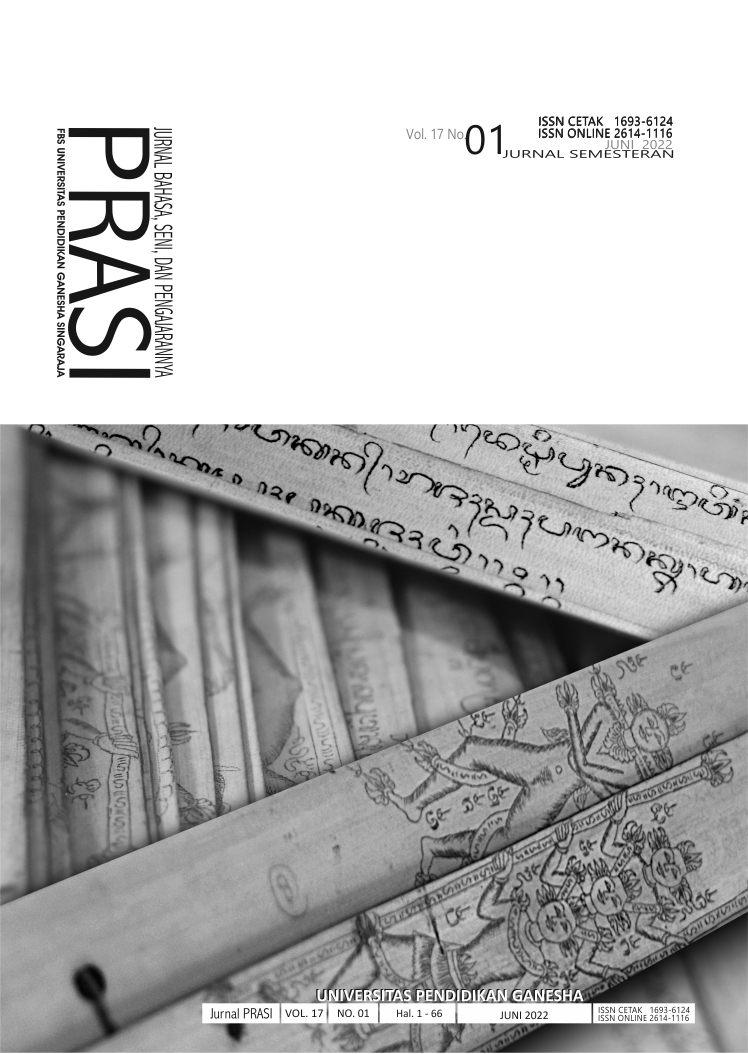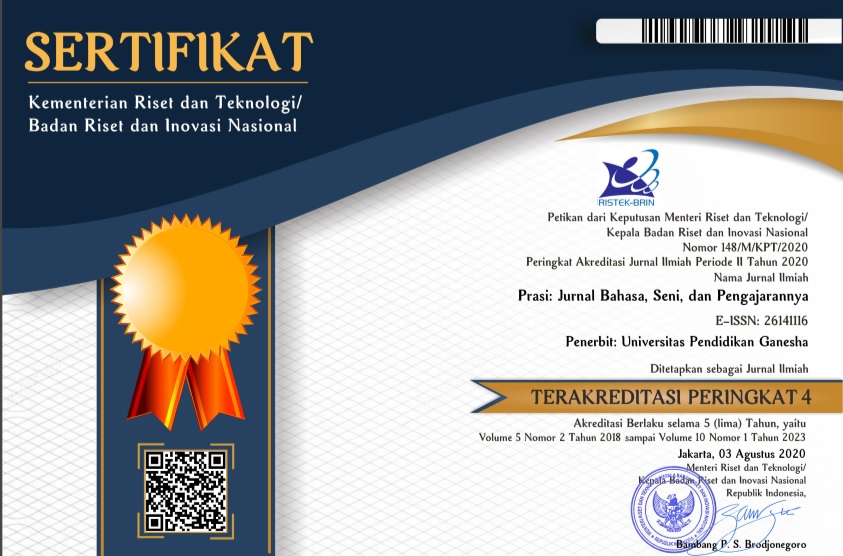DIFFERENTIATED INSTRUCTIONS: RELEVANT STUDIES ON ITS IMPLEMENTATION
DOI:
https://doi.org/10.23887/prasi.v17i1.41867Keywords:
Benefits, Challenges, Differentiated Instructions, ImplementationAbstract
Differentiated instructions have been recommended for classrooms with students of different readiness, learning profiles, and backgrounds in English classrooms. This study aimed at elaborating the implementation of differentiated instruction in terms of its advantages and the challenges encountered by teachers and students in implementing differentiated instruction. The study was designed as library research, following George's ten steps (2008) model. Experts' opinions and previous studies were reviewed in this present study to provide a comprehensive mapping of the advantages and challenges in implementing differentiated instructions. The review revealed that differentiated instruction could motivate low-achieving students, increase students' participation, interaction, and cooperation, as well as build a better teacher-student relationship. However, differentiated instruction also poses challenges, such as time-consuming, misperception about unfair treatments, and class size. These results imply that better planning should be conducted before implementing differentiated instruction to gain its benefits.References
Aftab, J. (2016). Teachers’ Beliefs about Differentiated Instructions in Mixed Ability Classrooms: A Case of Time Limitation. Journal of Education and Educational Development, 2(2), 94. https://doi.org/10.22555/joeed.v2i2.441
AL-Khayat, M. M., AL-Hrout, M. A., & Hyassat, M. A. (2017). Academically Gifted Undergraduate Students: Their Preferred Teaching Strategies. International Education Studies, 10(7), 155. https://doi.org/10.5539/ies.v10n7p155
Aldossari, A. T. (2018). The Challenges of Using the Differentiated Instruction Strategy: A Case Study in the General Education Stages in Saudi Arabia. International Education Studies, 11(4), 74. https://doi.org/10.5539/ies.v11n4p74
Ariantini, K. P., Suwastini, N. K. A., Adnyani, N. L. P. S., Dantes, G. R., & Jayantini, I. G. A. S. R. (2021). Integrating social media into English language learning: How and to what benefits according to recent studies. NOBEL: Journal of Literature and Language Teaching, 12(1), 91–111. https://doi.org/https://doi.org/10.15642/NOBEL.2021.12.1.91-111
Chen, J.-H., & Chen, Y.-C. (2018). Differentiated Instruction in a Calculus Curriculum for College Students in Taiwan. Journal of Education and Learning, 7(1), 88–95. https://doi.org/10.5539/jel.v7n1p88
Danley, A., & Williams, C. (2020). Choice in learning: Differentiating instruction in the college classroom. InSight: A Journal of Scholarly Teaching, 15, 83–104.
Dwiyanti, K. E., & Suwastini, N. K. A. (2021). Assessment for writing skills in online learning. Lingua Scientia, 28(1), 8–19. https://scholar.google.com/scholar?oi=bibs&cluster=5224360958189910644&btnI=1&hl=en
Endal, G., Padmadewi, N., & Ratminingsih, M. (2013). The effect of Differentiated Instruction and achievement motivation on students’ writing competency. E-Jouenal Program Pascasarjana Universitas Pendidikan Ganesha, 1, 1–10.
Ersani, N. P. D., Suwastini, N. K. A., Padmadewi, N. N., & Artini, L. P. (2021). Schemes of scaffolding in online education. Retorika: Jurnal Ilmu Bahasa, 7(1), 10–18.
https://doi.org/https://doi.org/10.22225/jr.7.1.2941.10-18
George, M. W. (2008). The elements of library research: What every student needs to know. Princeton University Press.
Ginja, T. G., & Chen, X. (2020). Teacher educators’ perspectives and experiences towards differentiated instruction. International Journal of Instruction, 13(4), 781–798. https://doi.org/10.29333/iji.2020.13448a
Ismajli, H., & Imami-Morina, I. (2018). Differentiated instruction: Understanding and applying interactive strategies to meet the needs of all the students. International Journal of Instruction, 11(3), 207–218. https://doi.org/10.12973/iji.2018.11315a
Joseph, S., Thomas, M., Simonette, G., & Ramsook, L. (2013). The impact of differentiated instruction in a teacher education setting: Successes and challenges. International Journal of Higher Education, 2(3), 28–40. https://doi.org/10.5430/ijhe.v2n3p28
Karadag, R., & Yasar, S. (2010). Effects of differentiated instruction on students’ attitudes towards Turkish courses: an action research. Procedia Social Behavioral Sciences, 9, 1394–1399. https://files.eric.ed.gov/fulltext/ED554550.pdf
Lavania, M., & Nor, F. B. M. (2020). Barriers in differentiated instruction: A systematic review of the literature. Journal of Critical Reviews, 7(6), 293–297. https://doi.org/10.31838/jcr.07.06.51
Magableh, I. S. I., & Abdullah, A. (2020). On the effectiveness of differentiated instruction in the enhancement of Jordanian students’ overall achievement. International Journal of Instruction, 13, 533–548. http://files.eric.ed.gov/fulltext/EJ1249110.pdf
Mitsi, P. (2017). Practical Implementation of Differentiated Teaching during School Age. British Journal of Education, Society & Behavioural Science, 19(3), 1–8. https://doi.org/10.9734/bjesbs/2017/31037
Sari, A. P., Agustini, D. A. E., & Adnyani, L. D. S. (2020). The Implementation of English Teacher’s Differentiated Instruction to Disabled Student in an Inclusive School. IJDS Indonesian Journal of Disability Studies, 7(2), 170–182. https://doi.org/10.21776/ub.ijds.2020.007.02.06
Shareefa, M., Zin, R. H. A. M., Nor Zaiham Midawati Abdullah, & Jawawi, R. (2019). Differentiated Instruction: Definition and Challenging Factors Perceived by Teachers. Advances in Social Science, Education and Humanities Research, 388(December), 322–327.
Siam, K., & Al-Natour, M. (2016). Teacher’s Differentiated Instruction Practices and Implementation Challenges for Learning Disabilities in Jordan. International Education Studies, 9(12), 167. https://doi.org/10.5539/ies.v9n12p167
Suwastini, N. K. A., Rinawati, N. K. A., Jayantini, I. G. A. S. R., & Dantes, G. R. (2021). Differentiated instruction across EFL classrooms: A conceptual review. TELL-US Journal, 7(1), 14–41. https://doi.org/http://dx.doi.org/10.22202/tus.2021.v7i1.4719
Tomlinson, C. A. (2000). Differentiation of instruction in the elementary grades. In ERIC Digests. ERIC Clearinghouse on Elementary and Early Childhood Education Champaign IL. http://files.eric.ed.gov/fulltext/ED443572.pdf
Tomlinson, C. A. (2014). The differentiated classroom responding to the needs of all learners (2nd editio). Association for Supervision and Curriculum Development.
Tomlinson, C. A., & Imbeau, M. B. (2010). Leading and managing a differentiated instruction. In Association for Supervision and Curriculum Development. Association for Supervision and Curriculum Development.
Tomlinson, C. A., & Moon, T. R. (2013). Assessment and student success in a differentiated classroom. Association for Supervision and Curriculum Development.
Tulbure, C. (2011). Do different learning styles require differentiated teaching strategies? Procedia - Social and Behavioral Sciences, 11, 155–159. https://doi.org/10.1016/j.sbspro.2011.01.052
Turner, W., Solis, O., & Kincade, D. (2017). Differentiating Instruction for Large Classes in Higher Education. International Journal of Teaching and Learning in Higher Education, 29(3), 490–500.
Downloads
Published
Issue
Section
License
Copyright (c) 2022 Gusti Ayu Mirawati, Ni Komang Arie Suwastini, Novi Diah Haryanti, I Gusti Agung Sri Rwa Jayantini

This work is licensed under a Creative Commons Attribution-NonCommercial-ShareAlike 4.0 International License.
Authors who publish with Prasi agree to the following terms:- Authors retain copyright and grant the journal the right of first publication with the work simultaneously licensed under a Creative Commons Attribution License (CC BY-SA 4.0) that allows others to share the work with an acknowledgment of the work's authorship and initial publication in this journal
- Authors are able to enter into separate, additional contractual arrangements for the non-exclusive distribution of the journal's published version of the work (e.g., post it to an institutional repository or publish it in a book), with an acknowledgment of its initial publication in this journal.
- Authors are permitted and encouraged to post their work online (e.g., in institutional repositories or on their website) prior to and during the submission process, as it can lead to productive exchanges, as well as earlier and greater citation of published work. (See The Effect of Open Access)


.png)
.png)









